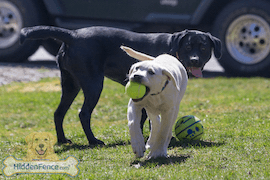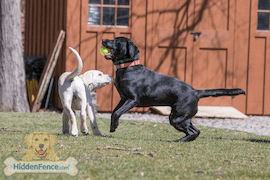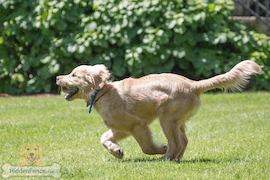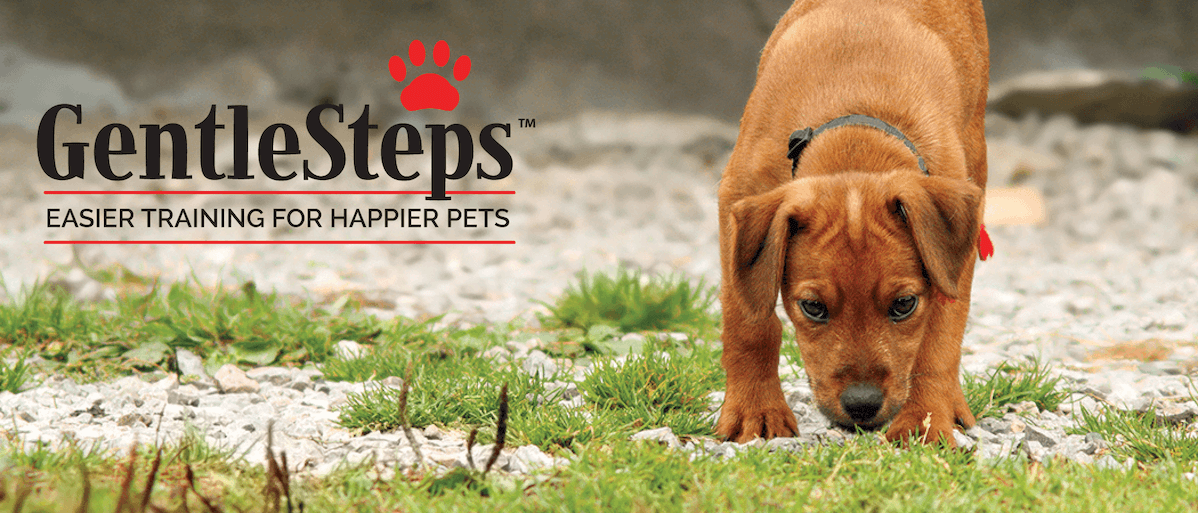Call/Text (973) 442 1111
Official Pet Stop® Owner’s Guide
Guide Table of Contents
Owner’s Guide > GentleSteps Training
GentleSteps Training Introduction
Introduction
A quick note about how GentleSteps™ was developed.
Over the years many individuals have contributed to refining the way pets are trained to electronic pet containment systems. Initially, all training was done using string and stakes with a collar that incorporated no warning tones or delays.
In the 1980’s fencing systems incorporated warning tones and yard flags to make training more fair and less stressful to the pet. Further developments remained essentially unchanged until 2001, when a new technique was developed inspired by the popular use of clicker and treat training.
This new technique significantly reduced the stress a pet typically experiences when first introduced to a system. While it is undeniable that many individuals contributed to developing this new technique, the behavior expert most credited with its development was Richard Weinssen of Hidden Fence in northern New Jersey.
As a member of the International Association of Canine Professionals, Rich believed in the humane approach to pet training. He saw an opportunity to develop a low stress approach by using a slow and gradual increase in correction, supplemented by frequent training sessions. This resulted in pets not only experiencing less correction during the training but also pets became trained effectively on far lower levels of correction than ever before.
When Rich joined the Pet Stop Dealer network, he brought with him this philosophy which inspired the creation of specially designed equipment to deliver this unique approach to training. Your local Pet Stop Professional is the only one who can offer equipment that is specifically designed to support this unique training technique. We call our equipment and the technique it supports – GentleSteps™ – a low stress and effective way to train your pet to the Pet Stop®, Pet Fence System.
GentleSteps is just one of the many ways the Pet Stop System is safer by design to give you greater peace of mind.
GentleSteps Training Guidelines
GentleSteps Training times may vary based on the individual dog. It may take a few days or up to a few weeks, plus supervised time ongoing.
Don’t use a containment system for a dog with existing or developing aggression problems. We recommend professional training help first.
REMEMBER, during any session, if dog seems particularly stressed for more than a minute or two, (eyes wide,
panting, agitated, frantic, tail tucked, pulling towards house, etc), take the collar off and spend extra time near
the flag line to calm your pet fully (10-20 minutes after the last correction) with belly rubs, back scratches,
treats and your own enthusiasm before going inside.
panting, agitated, frantic, tail tucked, pulling towards house, etc), take the collar off and spend extra time near
the flag line to calm your pet fully (10-20 minutes after the last correction) with belly rubs, back scratches,
treats and your own enthusiasm before going inside.
Training Overview
- Begin each session by preparing some outstanding treats. Try this! Cut up many small pieces of human grade beef or chicken.
-
Each session consists of 10-20 minutes of training followed by 10-20 minutes of play in the yard.
Two or more times daily. -
Following each session, continue with treats, ball or toy play and belly rubs well after fence training is
completed.
Your Training Preparation
GentleSteps Training success involves you as well as your dog. If you demonstrate sad or sympathetic behavior at any time during a session, this can confirm for the dog that something is wrong. Whereas a happy, playful, treat-generous handler will improve a pet’s mood more efficiently. The goal is to relate happy, playful interaction with the collar and the system.
Plan on a session taking 20 to 40 minutes so you can give your dog full attention during this training process.
Training Preparation for Your Dog
- Place collar on your dog 1 hour or more before training session and remove 1 hour after each training session
- Begin each training session in the yard with some treat rewarded basic commands, such as “Sit” or “Stay”
Note:
Collars should be removed at night to prevent neck sores. If your dog has a skin reaction, contact your veterinarian.
Training
Remember, each dog moves at their own pace.
Step One : Learning with Gentle Stimulation
Objective:
Teach your pet to turn the gentle stimulation on and off.
Goal:
This step allows your pet to make and learn from mistakes using gentle pressure.
Collar:
Setting should be between 1-3, increased incrementally.
Leash:
6’-20’ Leash on dog, held by handler. Handler allows dog to go no more than 2-3 feet into avoidance zone.
Time:
10-20 minute training followed by 10-20 minute play.
Training Plan:
- Repeat this step to teach your pet how to turn off the stimulation by backing up or to avoid turning it on by not advancing towards the flags.
- Time to play for 10-20 minutes, and remove dog’s collar an hour after the session.
Note
Do not allow longer corrections. Your pet’s responses may vary from very startled to unaware. The more mistakes your pet makes and can learn from at these lower levels, the less firm corrections will be needed lat er.
Helpful Hints:
Examples of mild temptations include family members standing 10 feet or further outside of the yard or outstanding taste value treats thrown 3-6 feet beyond the flags.
Remember:
Return the dog to the safe zone using the leash within 2-3 seconds and emphasize treats and or play.
- Using mild temptations, tempt your pet to approach or walk past the flags.
- The fence collar’s tone will sound when your pet enters the avoidance area.
- Using the leash, return your pet back into the safe zone of the yard within 2-3 seconds and reward generously.
When To Move On:
Progress to step 2 when your pet shows some avoidance to the flags and shows comfort 5-6 feet from the flags.
Step Two : Adding Temptation
Objective:
Teach your pet to turn the gentle stimulation on and off.
Goal:
This step strengthens your dogs avoidance of flags.
Collar:
Average collar setting: 3-6, increased incrementally.
Leash:
6’-20’ Leash on dog, held by handler.
Time:
10-20 minutes.
Training Plan:
After your dog has had their collar on for at least one hour and basic command practice with treats is complete:
- Since the collar setting is higher, handler should use leash to bring pet back to safe zone quickly, 1-2 seconds maximum.
- Use increased temptations, as your pet should now avoid the flags for mild distractions.
- Along with increased collar settings, handler should increase treats and play time.
- Temptations may include a family member walking quickly and playfully about 10’ outside the flag line, with dog and handler walking along flag line about 20’ behind family member.
- Pet may make multiple attempts to cross the flag line. Handler should keep mistakes brief and follow with cheer and treats.
Note:
Alternatively, in the event handler is working alone, toys thrown past the line can serve as temptations.
Helpful Hints:
Watch for passing neighbors, note bus stop schedules and look for neighbor activity that could serve as real world temptations.
- Repeat this step to strengthen flag line avoidance even with moderate real world temptations.
- Time to play for 10-20 minutes, and remove dog’s collar an hour after the session.
When To Move On:
Progress to step 3 when your pet avoids the flags for moderate temptations and shows comfort 5-6 feet from the flags.
Step Three:
Objective:
Give your dog time on their own in the yard.
Goal:
Your pet should avoid flags despite major distractions, but remain comfortable 3-6 feet into the safe zone for at least 60 days.
Collar:
At the highest setting required for your dog to meet avoidance.
Leash:
No Leash!
Time:
30-60 minutes daily.
Training Plan:
After your dog has had their collar on for at least one hour and basic command practice
with treats is complete:
- Your pet should be outside 30-60 minutes per day if possible.
- You are ready to allow your pet free run of the yard when your pet has not felt any corrections for at least 2-4 weeks.
When To Move On
-Flag Removal:
Flag removal: Between 30-60 days, remove every other flag.
Then every few days remove a few more until they are gone.
Then every few days remove a few more until they are gone.
Helpful Hints:
Flag removal: Between 30-60 days, remove every other flag.
Then every few days remove a few more until they are gone.
Then every few days remove a few more until they are gone.
Ongoing Maintenance Responsibilities
- Check system monthly, by walking dog collar to edge of yard and identifying where it beeps.
- Replace batteries at 4-6 month intervals, or when battery light flashes.
- Make sure collar is snug fitting, high on the neck near the ears and removed daily.
Title
Do not turn down the transmitter.The two digit reading relates to distance from the wire, not correction level.
Title
Check the Troubleshooting Guide or contact your dealer any time your Pet Stop system fails to perform properly.






